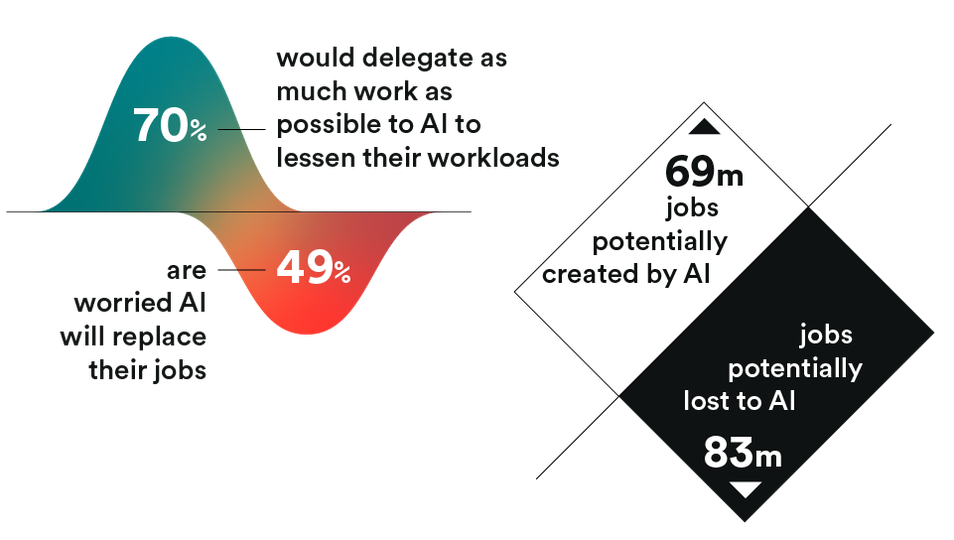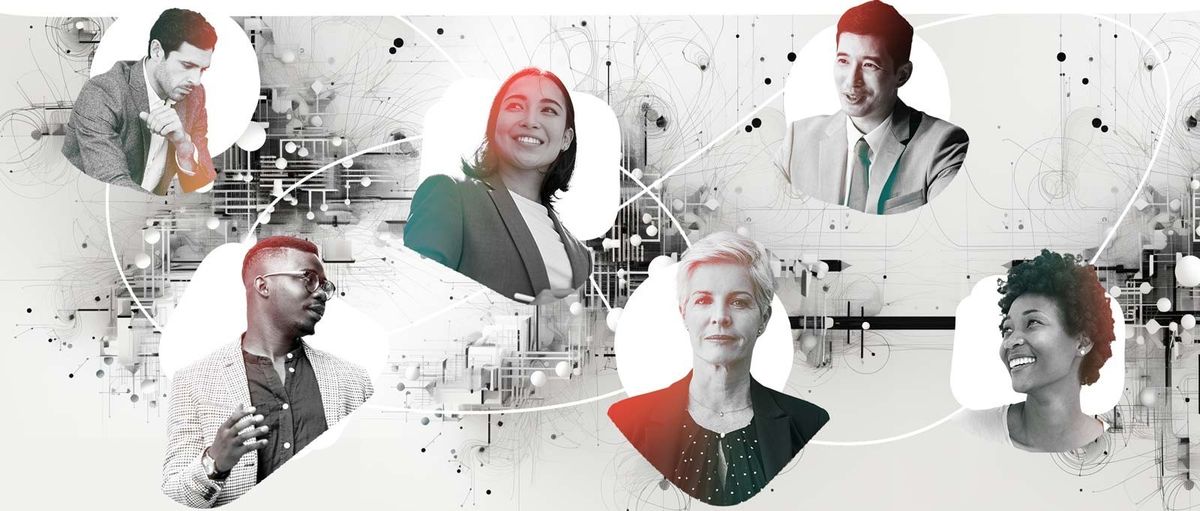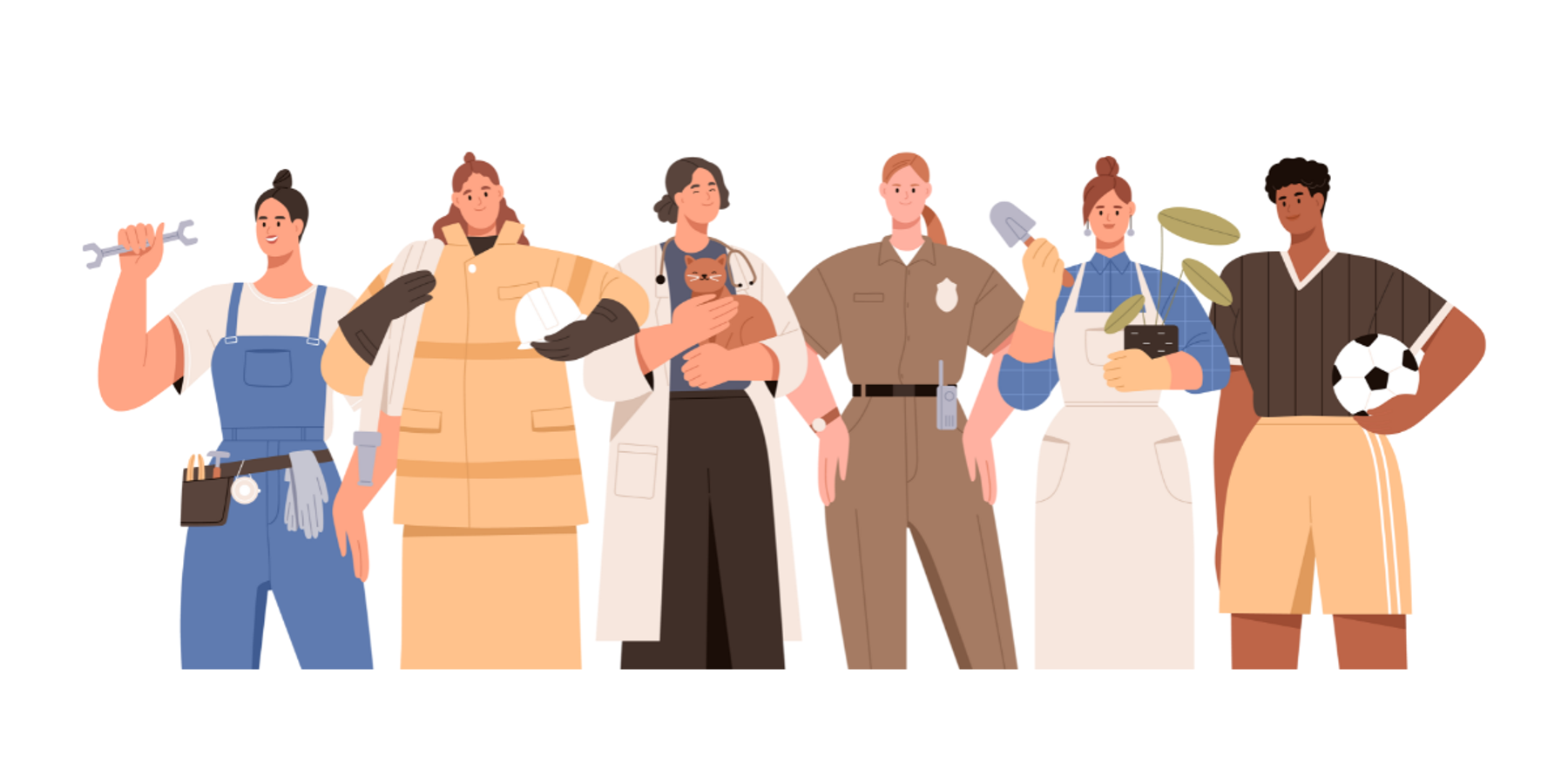HR and L&D leaders should see AI as a force for great leadership. But, for its potential to be realized, and its pitfalls avoided, key human qualities – communication, collaboration, empathy, critical thinking, and emotional judgement – must be prominent in all organizations.
AI will support decision-making, but the new “AI super-leader” will still make the decisions, working within a distributed power structure, and taking people with them.
These decisions will demand resolute focus on the business goals and solutions to be served by AI, and not solely on what AI can solve. These will be goals and solutions supported by data on a new scale, shaped and challenged by the human brain.
A radical refocusing of skills and resources will be required, but with the human leader still very much front and center. Here we explore why – and how – HR and L&D leaders can drive this critical shift in their organization.
Key insights
→ AI capabilities will quickly become available to all organizations, making technology less of a differentiator than the ability to use it to identify and drive business goals, and to adapt organization design and performance KPIs accordingly.
→ Organizations will need data on a new scale to fully harness the potential of AI. They must ensure they have the right data infrastructure in place, and that their people have the necessary skills to shape and challenge that data.
→ The AI super-leaders will be communicators, collaborators, and change-makers. Their decision-making will be emboldened by AI, but they will still make the final call. And they will guide their people through uncertainty and perpetual change.
AI and the workplace in numbers

/f/114723/1600x681/a86d2ec644/ai_data_human_thin.jpg)
Reimagining the organization and your people’s performance in an AI world
AI provides new opportunities for organizations to determine business goals – and more time to focus on realizing them
As more applications become technologically possible and easier to execute, the human/technology relationship will be redefined. Goals and their KPIs will need to be adjusted in line with new distributed decision-making and organizational design. HR and L&D leaders must make sure best-practice, progressive approaches are adopted – and fast.
Be careful of technology looking for solutions. Look for problems that can be solved with technology. Very easy to say – much harder to do.Philip Hult, Chairman EF Education First
Determining the right business goals will be paramount, as technology becomes less of a differentiator
As organizations increasingly have access to the same AI capabilities, thanks in large part to the growing availability of generative AI, they should be laser-focused on their greatest business opportunities and most pressing challenges. “Going forward, more focus should be on business solutions rather than technology-based business solutions,” says Terence Tse, Professor of Finance at Hult International Business School. “But in order to do that, people across the organization will need to acquire a high-level knowledge of what technology can do and how it works.”
Correctly identifying the business goals and problems that need solving will also become a key differentiator for organizations wishing to remain competitive. Ultimately, AI doesn’t always have to be the answer and there’s a danger in being deafened by the buzz surrounding it. “Be careful of technology looking for solutions. Look for problems that can be solved with technology. Very easy to say – much harder to do,” warns Philip Hult, Chairman of EF Education First, the world’s largest private education company, of which Hult EF is the B2B arm. The role of AI in solving those problems and supporting business opportunities must be carefully considered. “AI is best at accomplishing tasks that are standardized, routine, and repetitive,” says Tse. “AI can solve a lot of calculation problems but there are many more business problems that it cannot figure out, however much you train it. It’s the uniquely human skills of creativity, lateral thinking, and connecting the dots that are needed to do that.”
In a world of AI, success is dependent on relentless focus on setting goals and making decisions powered – but not made – by AI. This in turn hinges on having the right data.
/f/114723/500x500/3ec0dc6b5b/jennsen_quote.png)
"As all AI tools will be bought on a software license model, the real differentiator and competitive edge for businesses will be around the data they’re capable of feeding to the AI engine."
Jennsen Fung, Executive VP, Digital Marketing, EF Education First
AI will need data on a new scale – and the human brain to shape and challenge it
There has been a significant focus in recent years on being data-driven, but with arguably insufficient focus on whether the data – and the questions that are asked of it – are right.
To ensure they’re ready to capitalize on the upsides of AI, organizations need to focus now on getting the right infrastructure and clean data. AI tools do not necessarily need to be built in-house – they can be purchased, piped in, and augmented with proprietary data. “For generative AI to become a really robust, commercial, competitive tool, we should be thinking about training it with in-house data,” says Jennsen Fung, Executive VP, Digital Marketing, EF Education First. “As all AI tools will be bought on a software license model, the real differentiator and competitive edge for businesses will be around the data they’re capable of feeding to the AI engine.”
Equally, if not more, important is how the data is used. “We can give team members very clear directions on how to use the technology and data, but the more critical question is what are the key problems we want to solve? Is the issue about productivity or growth? Is it decision-making or protection? Once you have clarity on these and can marry them with the business priority, you can achieve whatever you need to do in a faster way,” continues Fung.
The time to start sorting out your data is now. “AI/machine learning will need data on a new scale,” says Hult. “To that end, we have been working hard for several years to get our data consolidated, accessible, and into agnostic formats. This work is very slow.”
There needs to be a deeper shift in how organizations allocate resources, autonomy, and delegation, so they’re not based on reinforcement of power at the top.Mark Esposito, Professor of Economics and Strategy at Hult International Business School
Performance KPIs and organization design must adapt to high-speed change
Part of the data requirement to inform fast, good decision-making will come from KPIs. These will need to be fundamentally different to reflect the high-change environment that AI will invariably create. “Performance measurement cannot be predetermined by KPIs looking at the past,” says Mark Esposito, Professor of Economics and Strategy at Hult International Business School. “How do we use anticipation to anchor performance measures in what will happen in the future? Otherwise, we’re creating a consistent form of discrimination based on KPIs that do not match the challenges of the job.”
Esposito believes organizations need to become experimental by taking more of a hypothesizing and testing approach and not just assuming they know the answer. “It requires leadership in the purest form to assess the viability of KPIs and the ability to challenge them,” says Esposito. The sandbox testing and experimentation method, for example, has been successful in setting KPIs and measuring them, using interdisciplinary ideas and thinking to test approaches in real-time.
Rapid decision-making is also dependent on having the right organizational structure to support it. Organizations must move from hierarchical structures to networks enabling distributed decision-making and risk-taking. Esposito continues: “There needs to be a deeper shift in how organizations allocate resources, autonomy, and delegation, so they’re not based on reinforcement of power at the top. This is an act of trust that only happens in an organization where you’re leading toward the future, rather than just managing the process itself.”

Actions for HR and L&D leaders to support reimagining the organization and people’s performance
1. Focus on business objectives, not technology
Expand the range of skills across your organization, including building digital-savviness. The soft skills of creativity, lateral thinking, and connecting the dots need a particular focus.
2. Build data infrastructure at scale – and the capacity to challenge it
Support teams in moving to a new model for data. Strengthen the skills they need to treat data in a more strategic, critical way.
3. Respond to the rapid speed of change with new KPIs and organization design
Ensure KPIs are meaningful and the right ways of measuring them are in place. Identify ways of quickly and flexibly allocating resources and delegating. A network rather than a hierarchy-based approach is likely to work best. Help your people embrace volatility as a positive form of evolution.
/f/114723/1600x681/db15a89881/ai_connections_gradient-thin.jpg)
The new AI super-leader: communicator, collaborator, and change-maker
As AI forces a reimagining of the organization and those needed to operate within it, human qualities are becoming increasingly important. New AI super-leaders will need to emerge, who will use AI tools to inform their decision-making but still make the final call themselves – and not necessarily that suggested by AI. These AI super-leaders will need to include the people around them in making decisions, working in a structure that is distributed rather than top-down. They will be communicators, collaborators, and change-makers. And their eyes will be pinned squarely on the future.
/f/114723/500x500/e4b7b5afea/terrence_quote.png)
“Technology should be an integral part of the whole C-suite’s jobs, rather than merely being delegated to the CTO.”
Terence Tse, Professor of Finance at Hult International Business School
Effective leadership will start with a broad perspective and a focus on the future
As AI accelerates the pace of change, organizations need the kind of leader who thinks about the bigger picture in which their organization is operating, acts accordingly, and is technologically savvy.
“Leaders need to have a wider perspective because of the rapid geopolitical, demographic, and market changes, not to mention understanding the different types of technologies that are emerging,” says Tse.
“I think leaders must have a broad view of what needs to be done internally and a willingness to step away from the day-to-day activities,” continues Tse. “They must be highly adaptable, able to act decisively and quickly, and be proactive in the way they connect and collaborate to make the most of opportunities.”
To judge and act decisively – and at speed – will require leaders to have an understanding of what digital can do and how it works, so their business decisions are informed by what’s possible. “Technology should be an integral part of the whole C-suite’s jobs,” says Tse, “rather than merely being delegated to the CTO. The thinking must be both business and technology – there shouldn’t be a distinction anymore.”
Decisions will be emboldened by AI but made by the human leader
Most of what a typical leader does is make decisions, with the big decisions that impact strategy, people, and organization the most critical. “AI is going to give us many more ingredients to make bold decisions,” says Jennsen Fung. “But the gatekeeper still has to be human.”
AI provides the opportunity to improve the quality of these decisions, by drawing on a bigger, broader dataset than is possible for the human. This helps make sure too much weight isn’t given to personal preferences that may be discriminatory. “Considering people’s unconscious bias, decision-making can be vastly improved if you allow computers to do the initial analysis of all the relevant data sources,” says Erik de Haan, Director of the Ashridge Centre for Coaching, part of Hult EF Corporate Education.
Nevertheless, de Haan believes the actual taking of the decision is still a highly sensitive, emotive, and ethical action that has a lot of consequences and so must still be taken by a person. “The best approach is for a human to take the information and analysis provided by AI and make the decision themselves,” he says. “AI can replicate the calculating mind, but it is not able to replicate the doubting, feeling, ethical or caring minds, which are essential in decision-making.”
Communication needs to operate at an emotional level. The human must always make the final decision in any communication.David Bish, Head of Academic Affairs at Hult EF Corporate Education
Leadership will be more about communication, consultation, and bringing people together – and less about top-down instructions
Once the decision is made, AI super-leaders bring their people together behind it by engaging rather than instructing. Effective communication is core to this, allied with an understanding of what motivates people.
AI can perform a useful function in testing the waters of what teams want and need. “AI has the capability to help you establish what points need addressing through passively scanning online communications, whether that’s emails, social media, or chat activity,” says David Bish, Head of Academic Affairs at Hult EF Corporate Education. “This can help spot critical information or communication gaps.”
In fact, AI is now being used to perform many kinds of communication – online chat, email and document drafting, to name but a few. And to a certain degree, generative AI, such as ChatGPT, has the ability to emulate the communication style of a human, through choice of tone or language according to the emotion it is told to portray. But given the importance of communication in business, leaders need to exercise careful judgement in deciding when and where to use it.
Communications that are crucial to the success of a team arguably need a high proportion of human input, if not being entirely generated by the human. “When a leader needs to communicate about a change that is sensitive or controversial, the choice of language and demonstration of empathy are crucial – and depend on a deep understanding of the situation and the concerns of the audience,” says Bish. “Communication needs to operate at an emotional level. The human must always make the final decision in any communication.”
/f/114723/500x500/1f27dd678c/riaz_quote.png)
“Critical thinking, emotional intelligence, and creativity are the skills that will enable humans to compete.”
Riaz Shah, EY’s Global Learning Leader
The AI super-leader will guide their people through uncertainty, supported by HR and L&D
In what is an increasingly uncertain world, leaders need to be able to create a feeling of confidence and excitement for their people. For Riaz Shah, EY’s Global Learning Leader and member of the Adjunct Faculty at Hult International Business School, the ability to lead in uncertain times is what leadership is all about. “Being able to set an exciting vision for people, and work with people to develop a plan, along with the view of how what you’re doing fits into the overall why – all of those qualities haven’t changed, and they won't change going forward.”
Function leaders must ensure AI serves the needs of the business. At the same time, HR and learning leaders must support their people in becoming more adaptable and having a learning mindset. “Critical thinking, emotional intelligence, and creativity are the skills that will enable humans to compete,” says Shah. “How do you increase these skills in your organization and become more of a learn-it-all culture rather than a know-it-all culture? I think it’s down to HR and learning leaders to excite people to want to learn new skills.”
“Leaders ought to provide certainty to people where there is none,” continues Shah. “We don’t like uncertainty – we like to have the answers, but we increasingly won’t have them. I always say you don’t need to have the answers, what you need is to ask the right questions. The smartest people are always revising their understanding of something they thought they’d already solved. And they’re open to contradictions to their way of thinking,” he says.
“So, I think the job of a leader is to give everybody a vision and be clear on the why. But also make people realize that these are times of uncertainty and, although we don’t know what the answers are, that’s okay because we can ask more questions. And that’s a great way of getting more innovation and creativity in our businesses,” concludes Shah.

Actions for HR and L&D leaders to support the new AI super-leader
1. Focus on the bigger picture
Ensure your leaders have a broad perspective and are adaptable, proactive, and future-focused – while having a fundamental understanding of tech and what it can do. The next generation of corporate education will be about developing the ability to think deeper and beyond what can be observed. Critical thinking, emotional intelligence, and creativity will be key.
2. Support better decision-making
Put more focus on enabling effective decision-making and empowerment leadership. The classical forms of corporate learning – involving facts, theories, systems, and processes – are arguably less useful than coaching, backed up by immersive, in-person learning experience.
3. Over-index on communication, collaboration, and consultation
Reinforce core leadership skills through L&D and broader cultural change activities. Beyond L&D, these qualities must be visibly modeled throughout your organization, particularly by your high-profile leaders.
4. Become comfortable with uncertainty, ambiguity, and change
Help your people embrace change by giving them tools to work positively with it, whether methodologies, learning or coaching. Drive the move to a culture where people are open to constantly revising their understandings.
In a world of AI, the human leader must be the change-maker
While AI can in part mimic the human experience, it remains for the human leader to be the driving force of change – enabled by AI as a powerful tool, but not led by it.
The challenge is now on for HR and L&D leaders to enable their organizations and people to embrace this new dynamic and realize AI’s full potential. It remains up to the human leader to understand the organizational design, technology and data required to support the right goal setting and decision-making to achieve competitive advantage.
In a world of AI, the true power lies with the people of an organization and their uniquely human qualities – communication, collaboration, creativity, empathy, critical thinking, and emotional judgement. These qualities come together in “AI super-leaders” – the empowered decision-makers who focus on the future, inspiring others to come with them, and bringing about long-lasting and potentially radical change. It’s up to HR and L&D leaders to recognize the need for those unique qualities in their organizations, to protect them and to develop them – if they are to derive full potential from the advantages AI offers.
Coming up next
We will explore the impact of AI on learning and development in our upcoming series of articles.
In the field of language learning, we will investigate how AI will shift the focus from native vs. non-native teachers to human vs non-human teachers, and what the implications of that might be. We will dive into how AI can replicate the calculating mind but less the doubting, feeling mind – and how coaching can greatly help with the latter. And, finally, we will explore how leadership development will evolve to support the needs of the AI super-leader.
Save your seat for our AI webinar
This upcoming webinar brings together a panel of experts to dive deep and explore "What’s left for the human leader in a world of AI?". It will provide you with the insights you need to enable your organizations and leaders to realize the full potential that AI can provide.
Join our panellists for this live 60-minute webinar on Tuesday, September 12 at 14:00 GMT+1 (BST) / 15:00 CEST.
Register here



